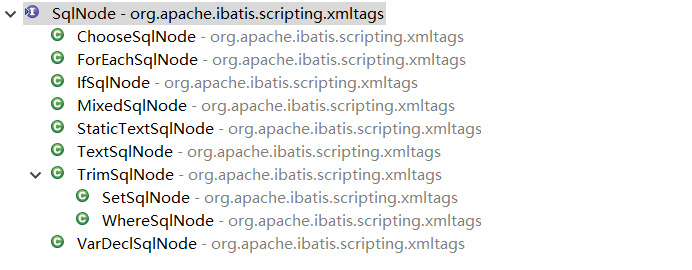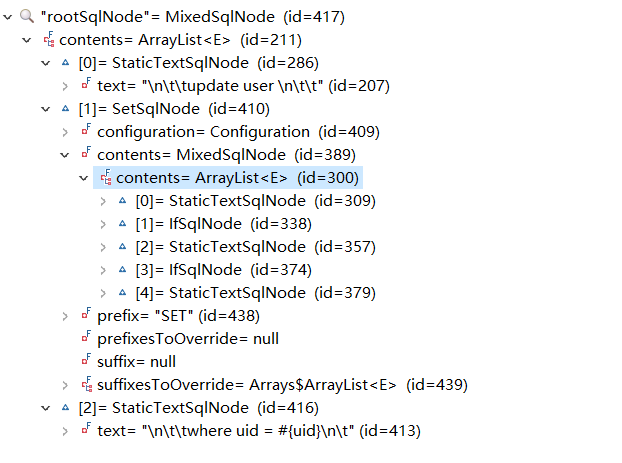Mybatis源码分析(二)XML的解析和Annotation的支持
上一节内容我们简单回顾了Mybatis的整体架构和相关概念知识点,并简述了本系列所用框架的版本。Mybatis功能强大,花样繁多。我们不会太关心所有的技术点,而是重点剖析常用的功能点。同Spring相比,Mybatis多以应用为主。从本节开始,我们正式开始源码的分析。
二、环境配置
每个基于 MyBatis 的应用都是以一个 SqlSessionFactory 的实例为中心的,SqlSessionFactory 的实例可以通过 SqlSessionFactoryBuilder 获得。而 SqlSessionFactoryBuilder 则可以从 XML 配置文件或一个预先定制的 Configuration 的实例构建出 SqlSessionFactory 的实例。例如:
String resource = "org/mybatis/example/mybatis-config.xml"; InputStream inputStream = Resources.getResourceAsStream(resource); SqlSessionFactory sqlSessionFactory = new SqlSessionFactoryBuilder().build(inputStream); 复制代码
当然,上面这些是Mybatis官方的样例。不过,我们日常开发中Mybatis都是与Spring一起使用的,交给Spring去搞定这些岂不更好。
<bean id="sqlSessionFactory" class="org.mybatis.spring.SqlSessionFactoryBean"> <property name="dataSource" ref="dataSource" /> <property name="mapperLocations" value="classpath:com/viewscenes/netsupervisor/mapping/*.xml"></property> <property name="typeAliasesPackage"> <array> <value>com.viewscenes.netsupervisor.entity</value> </array> </property> </bean> 复制代码
三、初始化
我们来到 org.mybatis.spring.SqlSessionFactoryBean ,看到它实现了 InitializingBean 接口。这说明,在这个类被实例化之后会调用到 afterPropertiesSet() 。它只有一个方法
public void afterPropertiesSet() throws Exception {
this.sqlSessionFactory = buildSqlSessionFactory();
}
复制代码
四、两个接口
1、SqlSessionFactory
SqlSessionFactory是一个接口,它里面其实就两个方法: openSession、getConfiguration 。
package org.apache.ibatis.session;
public interface SqlSessionFactory {
SqlSession openSession();
SqlSession openSession(boolean autoCommit);
SqlSession openSession(Connection connection);
SqlSession openSession(TransactionIsolationLevel level);
SqlSession openSession(ExecutorType execType);
SqlSession openSession(ExecutorType execType, boolean autoCommit);
SqlSession openSession(ExecutorType execType, TransactionIsolationLevel level);
SqlSession openSession(ExecutorType execType, Connection connection);
Configuration getConfiguration();
}
复制代码
我们知道,可以通过openSession方法获取一个SqlSession对象,完成必要数据库增删改查功能。但是,SqlSessionFactory属性也太少了,那些mapper映射文件、SQL参数、返回值类型、缓存等属性都在哪呢?
2、Configuration
Configuration,你可以把它当成一个数据的大管家。MyBatis所有的配置信息都维持在Configuration对象之中,基本每个对象都会持有它的引用。正是应了那句话 我是革命一块砖,哪里需要往哪搬 。下面是部分属性
public class Configuration {
//环境
protected Environment environment;
protected boolean safeRowBoundsEnabled;
protected boolean safeResultHandlerEnabled = true;
protected boolean mapUnderscoreToCamelCase;
protected boolean aggressiveLazyLoading;
protected boolean multipleResultSetsEnabled = true;
protected boolean useGeneratedKeys;
protected boolean useColumnLabel = true;
protected boolean cacheEnabled = true;
protected boolean callSettersOnNulls;
protected boolean useActualParamName = true;
protected boolean returnInstanceForEmptyRow;
//日志信息的前缀
protected String logPrefix;
//日志接口
protected Class<? extends Log> logImpl;
//文件系统接口
protected Class<? extends VFS> vfsImpl;
//本地Session范围
protected LocalCacheScope localCacheScope = LocalCacheScope.SESSION;
//数据库类型
protected JdbcType jdbcTypeForNull = JdbcType.OTHER;
//延迟加载的方法
protected Set<String> lazyLoadTriggerMethods = new HashSet<String>(
Arrays.asList(new String[] { "equals", "clone", "hashCode", "toString" }));
//默认执行语句超时
protected Integer defaultStatementTimeout;
//默认的执行器
protected ExecutorType defaultExecutorType = ExecutorType.SIMPLE;
//数据库ID
protected String databaseId;
//mapper注册表
protected final MapperRegistry mapperRegistry = new MapperRegistry(this);
//拦截器链
protected final InterceptorChain interceptorChain = new InterceptorChain();
//类型处理器
protected final TypeHandlerRegistry typeHandlerRegistry = new TypeHandlerRegistry();
//类型别名
protected final TypeAliasRegistry typeAliasRegistry = new TypeAliasRegistry();
//语言驱动
protected final LanguageDriverRegistry languageRegistry = new LanguageDriverRegistry();
//mapper_id 和 mapper文件的映射
protected final Map<String, MappedStatement> mappedStatements = new StrictMap<MappedStatement>(
"Mapped Statements collection");
//mapper_id和缓存的映射
protected final Map<String, Cache> caches = new StrictMap<Cache>("Caches collection");
//mapper_id和返回值的映射
protected final Map<String, ResultMap> resultMaps = new StrictMap<ResultMap>("Result Maps collection");
//mapper_id和参数的映射
protected final Map<String, ParameterMap> parameterMaps = new StrictMap<ParameterMap>("Parameter Maps collection");
//资源列表
protected final Set<String> loadedResources = new HashSet<String>();
未完.......
}
复制代码
五、构建SqlSessionFactory
在 afterPropertiesSet 方法只有一个动作,就是buildSqlSessionFactory。它可以分为两部分来看,先从配置文件的 property 属性中加载各种组件,解析配置到configuration中,然后加载mapper文件,解析SQL语句,封装成MappedStatement对象,配置到configuration中。
1、配置property属性
- typeAliases
这是一个类型的别名,很好用。比如在user_mapper的方法中,resultType和parameterType想使用实体类映射,而不用写全限定类名。
//这里的resultType就是别名
//它对应的是com.viewscenes.netsupervisor.entity.User
<select id="getUserById" resultType="user">
select * from user where uid=#{uid}
</select>
复制代码
它有两种配置方式,指定包路径或者指定类文件的路径。
<property name="typeAliasesPackage"> <array> <value>com.viewscenes.netsupervisor.entity</value> </array> </property> 或者 <property name="typeAliases"> <array> <value>com.viewscenes.netsupervisor.entity.User</value> </array> </property> 复制代码
它的解析很简单,就是拿到类路径的反射对象,key为默认类名小写,value为Class对象,注册到容器中。当然了,你也可以使用@Alias注解来设置别名的名称。
public void registerAlias(Class<?> type) {
String alias = type.getSimpleName();
Alias aliasAnnotation = type.getAnnotation(Alias.class);
if (aliasAnnotation != null) {
alias = aliasAnnotation.value();
}
String key = alias.toLowerCase(Locale.ENGLISH);
TYPE_ALIASES.put(key, type);
}
复制代码
TYPE_ALIASES容器就是一个HashMap,里面已经默认添加了很多的类型别名。
registerAlias("string", String.class);
registerAlias("byte", Byte.class);
registerAlias("long", Long.class);
registerAlias("short", Short.class);
registerAlias("int", Integer.class);
registerAlias("integer", Integer.class);
registerAlias("double", Double.class);
registerAlias("float", Float.class);
registerAlias("boolean", Boolean.class);
......未完
复制代码
- typeHandlers
它是一个类型的处理器。在数据库查询出结果后,应该转换成Java中的什么类型?由它来决定。如果Mybatis里面没有你想要的,就可以在这里自定义一个处理器。 这块内容,在后续章节我将通过一个实例独立讲解。现在,先来看下它的默认处理器。
register(JdbcType.BOOLEAN, new BooleanTypeHandler()); register(JdbcType.TINYINT, new ByteTypeHandler()); register(JdbcType.SMALLINT, new ShortTypeHandler()); register(Integer.class, new IntegerTypeHandler()); register(JdbcType.INTEGER, new IntegerTypeHandler()); register(JdbcType.FLOAT, new FloatTypeHandler()); register(JdbcType.DOUBLE, new DoubleTypeHandler()); register(String.class, new StringTypeHandler()); register(String.class, JdbcType.CHAR, new StringTypeHandler()); register(String.class, JdbcType.CLOB, new ClobTypeHandler()); register(String.class, JdbcType.VARCHAR, new StringTypeHandler()); register(String.class, JdbcType.LONGVARCHAR, new ClobTypeHandler()); register(String.class, JdbcType.NVARCHAR, new NStringTypeHandler()); register(String.class, JdbcType.NCHAR, new NStringTypeHandler()); register(String.class, JdbcType.NCLOB, new NClobTypeHandler()); register(JdbcType.CHAR, new StringTypeHandler()); register(JdbcType.VARCHAR, new StringTypeHandler()); register(JdbcType.CLOB, new ClobTypeHandler()); register(JdbcType.LONGVARCHAR, new ClobTypeHandler()); .....未完 复制代码
- plugins
可以配置一个或多个插件。插件功能很强大,在执行SQL之前,在返回结果之后,在插入数据时...都可以让你有机会插手数据的处理。这个部分最常用的是分页,在后续章节,笔者将通过分页和数据同步的实例单独讲解。
<property name="plugins"> <array> <bean class="com.viewscenes.netsupervisor.interceptor.xxxInterceptor"></bean> <bean class="com.viewscenes.netsupervisor.interceptor.xxxInterceptor"></bean> </array> </property> 复制代码
2、解析mapperLocations
mapperLocations配置的是应用中mapper文件的路径,获取所有的mapper文件。通过解析里面的 select/insert/update/delete 节点,每一个节点生成一个MappedStatement对象。最后注册到Configuration对象的mappedStatements。key为mapper的namespace+节点id。
先来看一下方法的整体。
public class XMLMapperBuilder extends BaseBuilder {
private void configurationElement(XNode context) {
//命名空间 即mapper接口的路径
String namespace = context.getStringAttribute("namespace");
if (namespace == null || namespace.equals("")) {
throw new BuilderException("Mapper's namespace cannot be empty");
}
//设置当前mapper文件的命名空间
builderAssistant.setCurrentNamespace(namespace);
//引用缓存
cacheRefElement(context.evalNode("cache-ref"));
//是否开启二级缓存
cacheElement(context.evalNode("cache"));
//参数
parameterMapElement(context.evalNodes("/mapper/parameterMap"));
//返回值
resultMapElements(context.evalNodes("/mapper/resultMap"));
//解析sql节点
sqlElement(context.evalNodes("/mapper/sql"));
//SQL语句解析
buildStatementFromContext(context.evalNodes("select|insert|update|delete"));
}
}
复制代码
- 缓存
通过在mapper文件中声明 </cache> 来开启二级缓存。通过获取缓存的配置信息来构建Cache的实例,最后注册到configuration。
private void cacheElement(XNode context) throws Exception {
//获取缓存的实例类型,在configuration初始化的时候注册
// typeAliasRegistry.registerAlias("PERPETUAL", PerpetualCache.class);
//typeAliasRegistry.registerAlias("FIFO", FifoCache.class);
//typeAliasRegistry.registerAlias("LRU", LruCache.class);
String type = context.getStringAttribute("type", "PERPETUAL");
Class<? extends Cache> typeClass = typeAliasRegistry.resolveAlias(type);
//LRU回收算法
String eviction = context.getStringAttribute("eviction", "LRU");
Class<? extends Cache> evictionClass = typeAliasRegistry.resolveAlias(eviction);
//刷新间隔
Long flushInterval = context.getLongAttribute("flushInterval");
//大小
Integer size = context.getIntAttribute("size");
//是否只读
boolean readWrite = !context.getBooleanAttribute("readOnly", false);
//是否阻塞
boolean blocking = context.getBooleanAttribute("blocking", false);
Properties props = context.getChildrenAsProperties();
builderAssistant.useNewCache(typeClass, evictionClass, flushInterval, size, readWrite, blocking, props);
}
复制代码
拿到这些属性后,将缓存设置到configuration。
//二级缓存是和mapper绑定的
//所以,这里的id就是mapper的命名空间
public void addCache(Cache cache) {
caches.put(cache.getId(), cache);
}
复制代码
- resultMap、parameterMap
它们表示的是查询结果集中的列与Java对象中属性的对应关系。其实,只有在数据库字段与JavaBean不匹配的情况下才用到,通常情况下推荐使用resultType/parameterType,也就是直接利用实体类即可。这种方式很简便,同时遵循约定大于配置,代码出错的可能较小。
中间过程不看了,最后他们也都是注册到configuration。
public void addParameterMap(ParameterMap pm) {
parameterMaps.put(pm.getId(), pm);
}
public void addResultMap(ResultMap rm) {
resultMaps.put(rm.getId(), rm);
}
复制代码
- SQL标签
SQL标签可将重复的sql提取出来,使用时用include引用即可,最终达到sql重用的目的。它的解析很简单,就是把内容放入sqlFragments容器。id为命名空间+节点ID
- SELECT、INSERT、UPDATE、DELETE
动态SQL的解析是Mybatis的核心所在。之所以是动态SQL,源自它不同的动态标签,比如 Choose、ForEach、If、Set 等,而Mybatis把它们都封装成不同的类对象,它们共同的接口是SqlNode。

每一种标签又对应一种处理器。
private void initNodeHandlerMap() {
nodeHandlerMap.put("trim", new TrimHandler());
nodeHandlerMap.put("where", new WhereHandler());
nodeHandlerMap.put("set", new SetHandler());
nodeHandlerMap.put("foreach", new ForEachHandler());
nodeHandlerMap.put("if", new IfHandler());
nodeHandlerMap.put("choose", new ChooseHandler());
nodeHandlerMap.put("when", new IfHandler());
nodeHandlerMap.put("otherwise", new OtherwiseHandler());
nodeHandlerMap.put("bind", new BindHandler());
}
复制代码
- 静态SQL
静态SQL,就是不带上面那些标签的节点。它比较简单,最后就是将SQL内容封装到MixedSqlNode对象。MixedSqlNode对象里面有个List,封装的就是StaticTextSqlNode对象,而StaticTextSqlNode对象只有一个属性text,即SQL内容。
protected MixedSqlNode parseDynamicTags(XNode node) {
//SQL内容
String data = child.getStringBody("");
//生成TextSqlNode判断是否为动态SQL
TextSqlNode textSqlNode = new TextSqlNode(data);
if (textSqlNode.isDynamic()) {
contents.add(textSqlNode);
isDynamic = true;
} else {
contents.add(new StaticTextSqlNode(data));
}
return new MixedSqlNode(contents);
}
复制代码
如果是静态SQL,将SQL语句中的#{}转为?,返回StaticSqlSource对象 。
public StaticSqlSource(Configuration configuration, String sql, List<ParameterMapping> parameterMappings) {
this.sql = sql;
this.parameterMappings = parameterMappings;
this.configuration = configuration;
}
复制代码
- 动态SQL
一个动态SQL会分为不同的子节点,我们以一个UPDATE语句为例,尝试跟踪下它的解析过程。比如下面的UPDATE节点会分为三个子节点。两个静态节点和一个SET动态节点,而SET节点又分为两个IF动态节点。
<update id="updateUser" parameterType="user">
update user
<set>
<if test="username!=null">
username = #{username},
</if>
<if test="password!=null">
password = #{password},
</if>
</set>
where uid = #{uid}
</update>
[
[#text: update user ],
[set: null],
[#text: where uid = #{uid}]
]
复制代码
首先,获得当前的节点的内容,即updateUser。调用 parseDynamicTags
public class XMLScriptBuilder extends BaseBuilder {
//参数node即为当前UDATE节点的内容
protected MixedSqlNode parseDynamicTags(XNode node) {
List<SqlNode> contents = new ArrayList<SqlNode>();
//children分为3个子节点
//2个静态节点(update user和where id=#{id})
//1个动态节点set
NodeList children = node.getNode().getChildNodes();
for (int i = 0; i < children.getLength(); i++) {
XNode child = node.newXNode(children.item(i));
//如果是静态节点,将内容封装成StaticTextSqlNode对象
if (child.getNode().getNodeType() == Node.CDATA_SECTION_NODE || child.getNode().getNodeType() == Node.TEXT_NODE) {
String data = child.getStringBody("");
TextSqlNode textSqlNode = new TextSqlNode(data);
if (textSqlNode.isDynamic()) {
contents.add(textSqlNode);
isDynamic = true;
} else {
contents.add(new StaticTextSqlNode(data));
}
}
//动态节点
else if (child.getNode().getNodeType() == Node.ELEMENT_NODE) { // issue #628
//获取节点名称 比如SET/IF
String nodeName = child.getNode().getNodeName();
//获取节点标签对应的处理类 比如SetHandler
NodeHandler handler = nodeHandlerMap.get(nodeName);
handler.handleNode(child, contents);
isDynamic = true;
}
}
return new MixedSqlNode(contents);
}
}
复制代码
第一个是静态节点update user。根据上面的源码,它将被封装成StaticTextSqlNode对象,加入contents集合。
第二个是动态节点SET,他将调用到SetHandler.handleNode()。
private class SetHandler implements NodeHandler {
//nodeToHandle为SET节点的内容,targetContents为已解析完成的Node集合
public void handleNode(XNode nodeToHandle, List<SqlNode> targetContents) {
//回调parseDynamicTags
MixedSqlNode mixedSqlNode = parseDynamicTags(nodeToHandle);
//最终将SET节点封装成SetSqlNode,放入Node集合
SetSqlNode set = new SetSqlNode(configuration, mixedSqlNode);
targetContents.add(set);
}
}
复制代码
在第二次回调到 parseDynamicTags 方法时,这时候的参数为SET节点里的2个IF子节点。同样,它们会将当做动态节点解析,调用到IfHandler.handleNode()。
private class IfHandler implements NodeHandler {
//nodeToHandle为IF节点的内容, targetContents为已解析完成的Node集合
public void handleNode(XNode nodeToHandle, List<SqlNode> targetContents) {
//回调parseDynamicTags
MixedSqlNode mixedSqlNode = parseDynamicTags(nodeToHandle);
//获取IF标签的test属性,即条件表达式
String test = nodeToHandle.getStringAttribute("test");
//将IF节点封装成IfSqlNode对象,放入Node集合。
IfSqlNode ifSqlNode = new IfSqlNode(mixedSqlNode, test);
targetContents.add(ifSqlNode);
}
}
复制代码
就这样,递归的调用parseDynamicTags方法,直到传进来的参数Node为一个静态节点,返回StaticTextSqlNode对象,并加入集合中。 第三个是静态节点where id=#{id},封装成StaticTextSqlNode对象,加入contents集合。
最后,contents集合就是UPDATE节点对应的各种sqlNode。

如果是动态SQL,返回DynamicSqlSource对象。
public DynamicSqlSource(Configuration configuration, SqlNode rootSqlNode) {
this.configuration = configuration;
this.rootSqlNode = rootSqlNode;
}
复制代码
3、生成MappedStatement对象
mapper文件中的每一个 SELECT/INSERT/UPDATE/DELETE 节点对应一个MappedStatement对象。
public MappedStatement addMappedStatement() {
//全限定类名+方法名
id = applyCurrentNamespace(id, false);
//是否为查询语句
boolean isSelect = sqlCommandType == SqlCommandType.SELECT;
//配置各种属性
MappedStatement.Builder statementBuilder = new MappedStatement.Builder(configuration, id, sqlSource, sqlCommandType)
.resource(resource)
.fetchSize(fetchSize)
.timeout(timeout)
.statementType(statementType)
.keyGenerator(keyGenerator)
.keyProperty(keyProperty)
.keyColumn(keyColumn)
.databaseId(databaseId)
.lang(lang)
.resultOrdered(resultOrdered)
.resultSets(resultSets)
.resultMaps(getStatementResultMaps(resultMap, resultType, id))
.resultSetType(resultSetType)
.flushCacheRequired(valueOrDefault(flushCache, !isSelect))
.useCache(valueOrDefault(useCache, isSelect))
.cache(currentCache);
//参数类型
ParameterMap statementParameterMap = getStatementParameterMap(parameterMap, parameterType, id);
if (statementParameterMap != null) {
statementBuilder.parameterMap(statementParameterMap);
}
//将MappedStatement对象注册到configuration
//注册其实就是往Map中添加。mappedStatements.put(ms.getId(), ms);
MappedStatement statement = statementBuilder.build();
configuration.addMappedStatement(statement);
return statement;
}
复制代码
六、Annotation的支持
1、注解式的SQL定义
除了在mapper文件中配置SQL,Mybatis还支持注解方式的SQL。通过@Select,标注在Mapper接口的方法上。
public interface UserMapper {
@Select("select * from user ")
List<User> AnnotationGetUserList();
}
复制代码
或者你想要的是动态SQL,那么就加上 <script> 。
public interface UserMapper {
@Select("select * from user ")
List<User> AnnotationGetUserList();
@Select("<script>"
+ "select * from user "
+ "<if test='id!=null'>"
+ "where id=#{id}"
+ "</if>"
+ "</script>")
List<User> AnnotationGetUserById(@Param("id")String id);
}
复制代码
以上这两种方式都不常用,如果你真的不想用mapper.xml文件来定义SQL,那么以下方式可能适合你。你可以通过@SelectProvider来声明一个类的方法,此方法负责返回一个SQL的字符串。
public interface UserMapper {
@SelectProvider(type=SqlProvider.class,method="getUserById")
List<User> AnnotationProviderGetUserById(String id);
}
复制代码
types指定了类的Class,method就是类的方法。其实这种方式也很不错,动态SQL的生成不仅仅依靠Mybatis的动态标签,在程序中可以随便搞。
public class SqlProvider {
public String getUserById(String id) {
String sql = "select * from user ";
if (id!=null) {
sql += " where id="+id;
}
return sql;
}
}
复制代码
除了上面的@Select,当然还有对应其它几种的注解。
sqlAnnotationTypes.add(Select.class); sqlAnnotationTypes.add(Insert.class); sqlAnnotationTypes.add(Update.class); sqlAnnotationTypes.add(Delete.class); sqlProviderAnnotationTypes.add(SelectProvider.class); sqlProviderAnnotationTypes.add(InsertProvider.class); sqlProviderAnnotationTypes.add(UpdateProvider.class); sqlProviderAnnotationTypes.add(DeleteProvider.class); 复制代码
2、注解的扫描
上面我们看完了mapper文件中SQL的解析,下面来看注解是在哪里被扫描到的呢?
public class MapperRegistry {
public <T> void addMapper(Class<T> type) {
if (type.isInterface()) {
try {
MapperAnnotationBuilder parser = new MapperAnnotationBuilder(config, type);
parser.parse();
}
}
}
}
复制代码
type就是当前mapper接口的Class对象。获取Class对象的所有Method[]。
Method[] methods = type.getMethods();
for (Method method : methods) {
if (!method.isBridge()) {
parseStatement(method);
}
}
复制代码
parseStatement方法最终就生成MappedStatement对象,注册到configuration中,这个流程是与XML的方式一样,不会变的。
void parseStatement(Method method) {
//判断方法上是否包含那几种注解
//如果有,就根据注解的内容创建SqlSource对象。创建过程与XML创建过程一样
SqlSource sqlSource = getSqlSourceFromAnnotations(method, parameterTypeClass, languageDriver);
if (sqlSource != null) {
//获取各种属性,过程略过
......
//创建MappedStatement对象,注册到configuration
assistant.addMappedStatement();
}
}
复制代码
所以,我们看到。getSqlSourceFromAnnotations才是重点,拿到注解及注解上的值,创建SqlSource对象。
private SqlSource getSqlSourceFromAnnotations(Method method,
Class<?> parameterType, LanguageDriver languageDriver) {
//注解就分为两大类,sqlAnnotation和sqlProviderAnnotation
//循环注解列表,判断Method包含哪一种,就返回哪种类型注解的实例
Class<? extends Annotation> sqlAnnotationType = getSqlAnnotationType(method);
Class<? extends Annotation> sqlProviderAnnotationType = getSqlProviderAnnotationType(method);
//不能两种类型都配置哦
if (sqlAnnotationType != null) {
if (sqlProviderAnnotationType != null) {
throw new BindingException("You cannot supply both a static SQL and SqlProvider to method named " + method.getName());
}
Annotation sqlAnnotation = method.getAnnotation(sqlAnnotationType);
final String[] strings = (String[]) sqlAnnotation.getClass().getMethod("value").invoke(sqlAnnotation);
return buildSqlSourceFromStrings(strings, parameterType, languageDriver);
}else if (sqlProviderAnnotationType != null) {
Annotation sqlProviderAnnotation = method.getAnnotation(sqlProviderAnnotationType);
return new ProviderSqlSource(assistant.getConfiguration(), sqlProviderAnnotation, type, method);
}
return null;
}
复制代码
3、创建SqlSource对象
扫描到注解后,就要根据注解类型的不同,创建SqlSource对象。
- SELECT
我们以AnnotationGetUserList为例,它的注解是这样: @Select("select * from user ") 。最后创建SqlSource对象的过程与XML创建过程是一样的。
public SqlSource createSqlSource(Configuration configuration, String script, Class<?> parameterType) {
//如果是带script标签的内容,最终调用到parseDynamicTags方法。
//parseDynamicTags方法会递归调用,直到节点属性为静态节点。
if (script.startsWith("<script>")) {
XPathParser parser = new XPathParser(script, false, configuration.getVariables(), new XMLMapperEntityResolver());
return createSqlSource(configuration, parser.evalNode("/script"), parameterType);
}else {
script = PropertyParser.parse(script, configuration.getVariables());
TextSqlNode textSqlNode = new TextSqlNode(script);
if (textSqlNode.isDynamic()) {
return new DynamicSqlSource(configuration, textSqlNode);
}else {
//把#{}换成?,生成StaticSqlSource对象
return new RawSqlSource(configuration, script, parameterType);
}
}
}
复制代码
- SelectProvider
调用到ProviderSqlSource类的构造器,过程比较简单,就是拿到SqlProvider类上的方法,将方法名、方法参数和参数类型设置一下。
public ProviderSqlSource(Configuration configuration, Object provider, Class<?> mapperType, Method mapperMethod) {
String providerMethodName;
this.configuration = configuration;
this.sqlSourceParser = new SqlSourceBuilder(configuration);
this.providerType = (Class<?>) provider.getClass().getMethod("type").invoke(provider);
providerMethodName = (String) provider.getClass().getMethod("method").invoke(provider);
for (Method m : this.providerType.getMethods()) {
if (providerMethodName.equals(m.getName()) && CharSequence.class.isAssignableFrom(m.getReturnType())) {
this.providerMethod = m;
this.providerMethodArgumentNames = new ParamNameResolver(configuration, m).getNames();
this.providerMethodParameterTypes = m.getParameterTypes();
}
}
}
复制代码
4、注册
注册过程也同XML方式一样,生成MappedStatement对象,然后设置到configuration中。 configuration.addMappedStatement(statement);
七、总结
本章节主要阐述了Mybatis的启动过程之一,加载配置信息,解析SQL。最后生成SqlSessionFactory对象。
1、配置信息
Mybatis的配置信息较多,但也并非都需要。常用的就是缓存、类型转换器、类型别名、插件等。
2、解析SQL
生成SQL的方式大致有mapper.xml和Annotation两种。Annotation又分为SqlAnnotation和SqlProviderAnnotation,如果真的想要注解式的SQL,还是比较推荐SqlProviderAnnotation。
- 本文标签: 总结 entity Property plugin id 缓存 启动过程 数据 parse 管家 src 处理器 sqlsession 文件系统 ResultSet 定制 https UI 解析 插件 final build trigger 动态SQL iBATIS Statement root ip 配置 App list 开发 example autocommit mapper Collection JDBC apache db map CTO value 返回值类型 Connection ACE SqlSessionFactory IO equals 递归 update node sql 空间 key 参数 dataSource Word SqlSessionFactoryBuilder 二级缓存 ArrayList tag java tab cat 代码 XML 分页 同步 http bean executor session HashSet spring 源码 数据库 NSA 实例 mybatis provider core Action cache HashMap stream classpath tar IDE Select Result Maps
- 版权声明: 本文为互联网转载文章,出处已在文章中说明(部分除外)。如果侵权,请联系本站长删除,谢谢。
- 本文海报: 生成海报一 生成海报二











![[HBLOG]公众号](https://www.liuhaihua.cn/img/qrcode_gzh.jpg)

